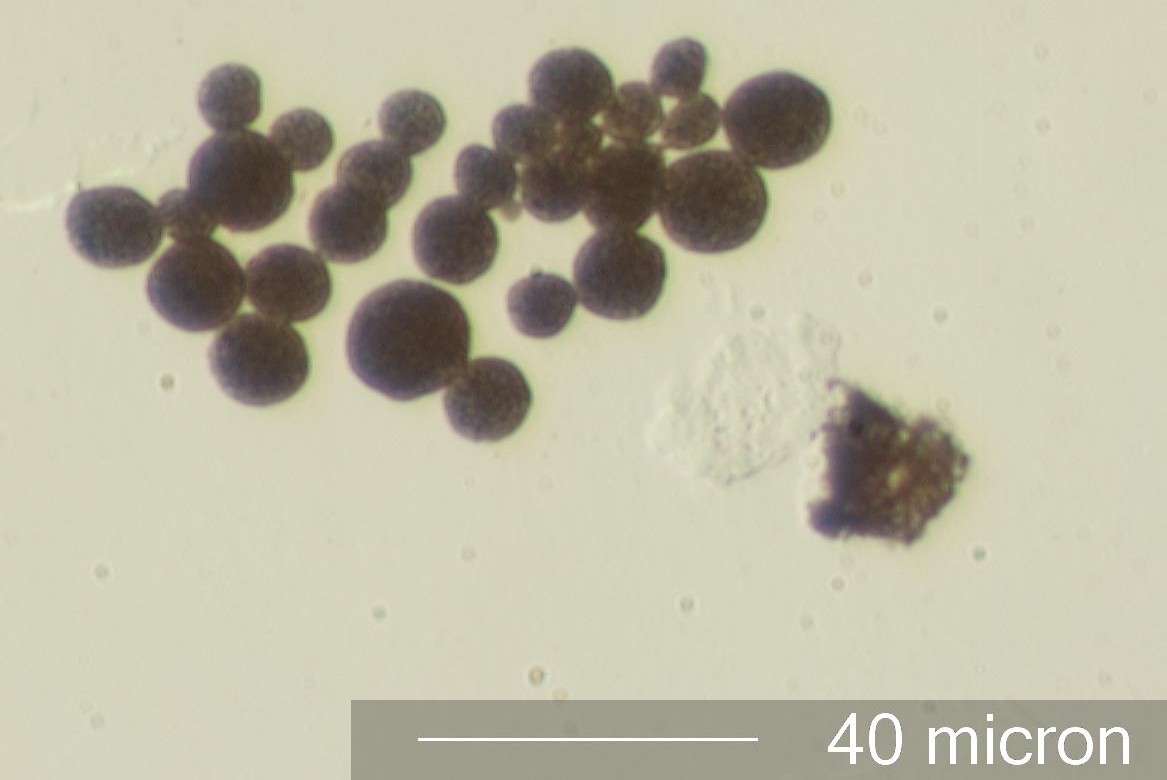Transmitted Off Crossed Circular Polarized Light
Definition/Function:
There are many different types of toner particles but they all share the fact that
they are composed of a pigment or dye in a
transparent thermoplastic matrix. The individual toner particles may be spherical,
globular, or irrigular in shape in there
unused condition. Once they have been bonded to paper they tend to be irregular in
shape and often exhibit plastic
deformation as a result of the forces that removed them from the paper to which they
had been bonded. Sometimes a small
fragment of paper will be attached to the toner particle that was worn from the
surface of the printed paper.
Significance in the Environment:
The presence of these particles in the environment indicate the presence of a printer or
copy machine. If unused toner
particles are found in the environment it suggests that the machine is not functioning
properly. There may be particle
emission or ozone emission issues associated with the machine. These may result in a
cosmetic problem (discoloring clothing),
irritation of mucus membranes, or other problems, depending on the nature a quantity of
materials being generated by the
printer or copier. Ozone is a known toxin but the hazards of the other materials that
are generated by printers and copiers
are unknown. Particles generated by printers and copiers tend to be predominantly from
the paper being used rather than
the toner or inks used in them. Some wear plastic and wear metal particles are created
from the moving parts of the machines
but most of the particle come from the paper being feed through the friction drive of
the machine. That is one of the many
reasons why particle counts around copy machines and printers tend to vary from time to
time with the same machine, the
same level of activity, and even with "similar" paper. Particle counters cannot
differentiate between toner, ink, particles
of wear, or paper sizing particles. Literature such as that published by Linda Morawska
(see below) should be interpreted cautiously,
as she, herself, suggests.
Characteristic Features:
Toner particle may be often be recognized their transparent matrix and the distribution
of pigment particles or dye. Some
toners contain very small, well dispersed pigment and may appear completely colored.
They will exhibit very little if any
reflectivity and no edge birefringence. Cenospheres exhibit much higher reflectivity and
show a complex surface texture not
seen in toner particles. Weld spheres exhibit edge birefringence between crossed
polarizers, are smooth, and show surface
reflectivity. Paint spheres tend to be much larger and generally include a greater
variety of materials, including pigments,
opacifiers, and bulking agents. The matrix for the toner particles is typically a
polyethylene, a polystyrene, or a polyester. The
polystyrene and some of the polyester matrices are soluble in acetone. In a tapelift
processed using acetone the matrix
will dissolve resulting in free pigment particles and thin films of matrix material
together under the tape at the location
of the original particle.
Associated Particles:
Toner particles are typical of office environments. They are typically found with
mechanically abraded paper, paper sizing,
toner coated paper fibers, and then with the other types of particles common in offices.
References:
http://en.wikipedia.org/wiki/Toner
Morawska, Lidia, Congrong He, and len Taplin, "Particle Emission Characteristics of
Office Printers", International
Laboratory for Air Quality and Health (Queensland University of Technology); Queensland
Department of Public Works, SF Gate,
2007-07-10, pp. 1–7.


